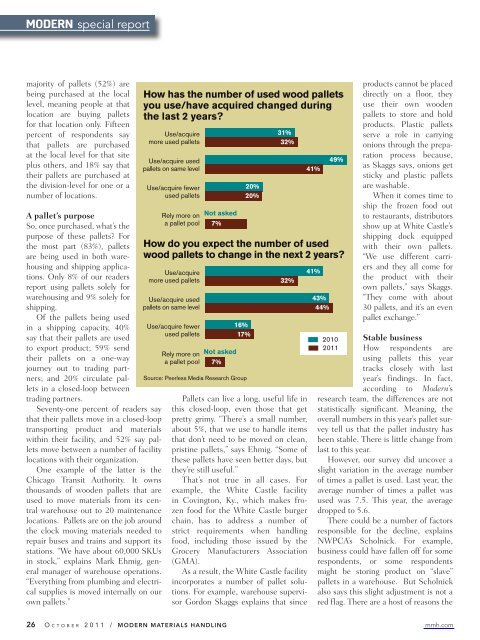You also want an ePaper? Increase the reach of your titles
YUMPU automatically turns print PDFs into web optimized ePapers that Google loves.
MODERN special reportmajority of pallets (52%) arebeing purchased at the locallevel, meaning people at thatlocation are buying palletsfor that location only. Fifteenpercent of respondents saythat pallets are purchasedat the local level for that siteplus others, and 18% say thattheir pallets are purchased atthe division-level for one or anumber of locations.A pallet’s purposeSo, once purchased, what’s thepurpose of these pallets? Forthe most part (83%), palletsare being used in both warehousingand shipping applications.Only 8% of our readersreport using pallets solely forwarehousing and 9% solely forshipping.Of the pallets being usedin a shipping capacity, 40%say that their pallets are usedto export product; 59% sendtheir pallets on a one-wayjourney out to trading partners;and 20% circulate palletsin a closed-loop betweentrading partners.Seventy-one percent of readers saythat their pallets move in a closed-looptransporting product and materialswithin their facility, and 52% say palletsmove between a number of facilitylocations with their organization.One example of the latter is theChicago Transit Authority. It ownsthousands of wooden pallets that areused to move materials from its centralwarehouse out to 20 maintenancelocations. Pallets are on the job aroundthe clock moving materials needed torepair buses and trains and support itsstations. “We have about 60,000 SKUsin stock,” explains Mark Ehmig, generalmanager of warehouse operations.“Everything from plumbing and electricalsupplies is moved internally on ourown pallets.”How has the number of used wood palletsyou use/have acquired changed duringthe last 2 years?Use/acquiremore used palletsUse/acquire usedpallets on same levelUse/acquire fewerused palletsRely more ona pallet poolNot asked7%Source: Peerless Media Research Group20%20%31%32%Pallets can live a long, useful life inthis closed-loop, even those that getpretty grimy. “There’s a small number,about 5%, that we use to handle itemsthat don’t need to be moved on clean,pristine pallets,” says Ehmig. “Some ofthese pallets have seen better days, butthey’re still useful.”That’s not true in all cases. Forexample, the White Castle facilityin Covington, Ky., which makes frozenfood for the White Castle burgerchain, has to address a number ofstrict requirements when handlingfood, including those issued by theGrocery Manufacturers Association(GMA).As a result, the White Castle facilityincorporates a number of pallet solutions.For example, warehouse supervisorGordon Skaggs explains that since41%49%How do you expect the number of usedwood pallets to change in the next 2 years?Use/acquiremore used palletsUse/acquire usedpallets on same levelUse/acquire fewerused palletsRely more ona pallet poolNot asked7%16%17%32%41%43%44%2010<strong>2011</strong>products cannot be placeddirectly on a floor, theyuse their own woodenpallets to store and holdproducts. Plastic palletsserve a role in carryingonions through the preparationprocess because,as Skaggs says, onions getsticky and plastic palletsare washable.When it comes time toship the frozen food outto restaurants, distributorsshow up at White Castle’sshipping dock equippedwith their own pallets.“We use different carriersand they all come forthe product with theirown pallets,” says Skaggs.“They come with about30 pallets, and it’s an evenpallet exchange.”Stable businessHow respondents areusing pallets this yeartracks closely with lastyear’s findings. In fact,according to <strong>Modern</strong>’sresearch team, the differences are notstatistically significant. Meaning, theoverall numbers in this year’s pallet surveytell us that the pallet industry hasbeen stable. There is little change fromlast to this year.However, our survey did uncover aslight variation in the average numberof times a pallet is used. Last year, theaverage number of times a pallet wasused was 7.5. This year, the averagedropped to 5.6.There could be a number of factorsresponsible for the decline, explainsNWPCA’s Scholnick. For example,business could have fallen off for somerespondents, or some respondentsmight be storing product on “slave”pallets in a warehouse. But Scholnickalso says this slight adjustment is not ared flag. There are a host of reasons the26 O C T O B E R 2 0 1 1 / MODERN MATERIALS HANDLING mmh.com
















